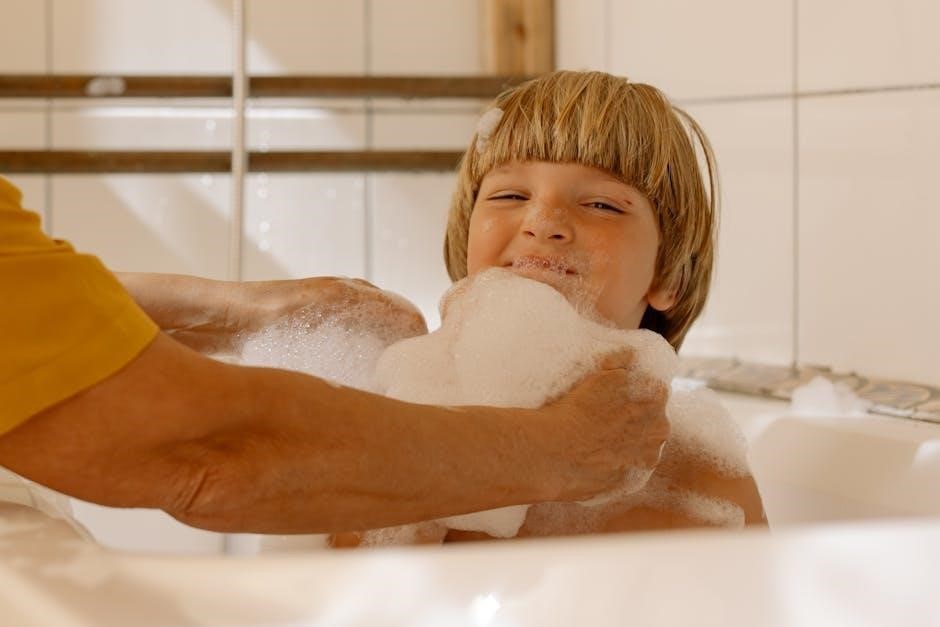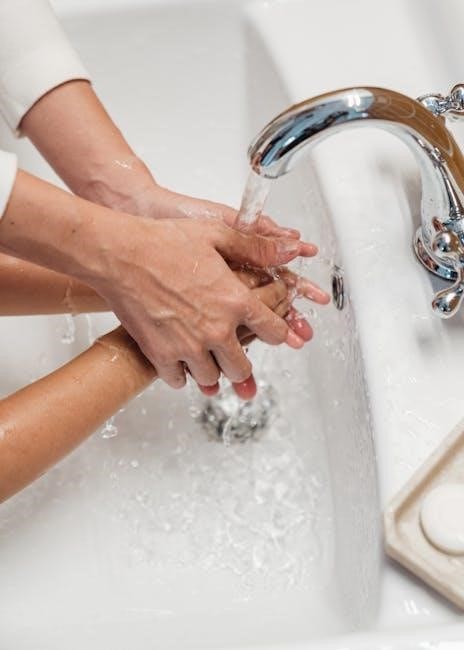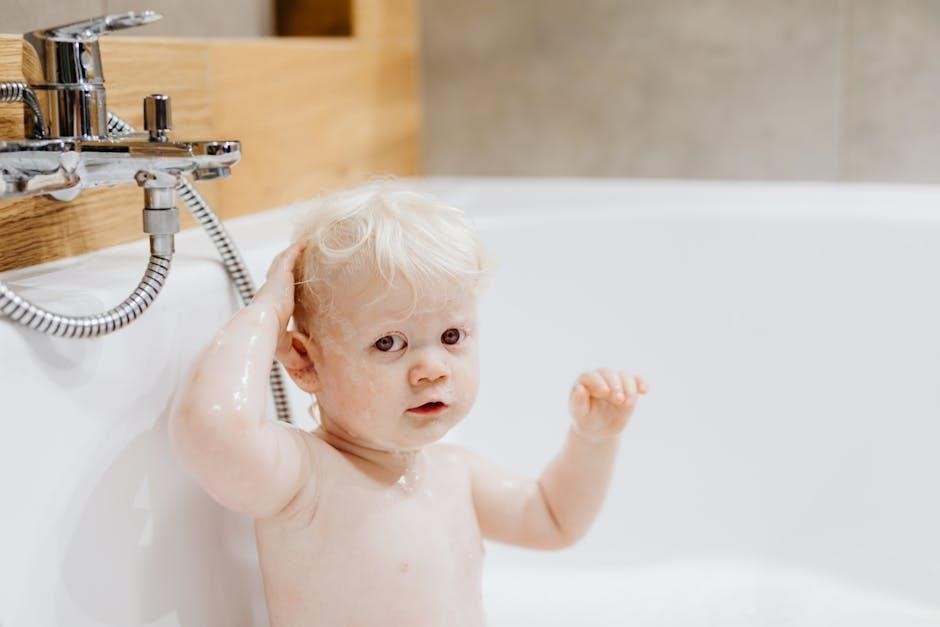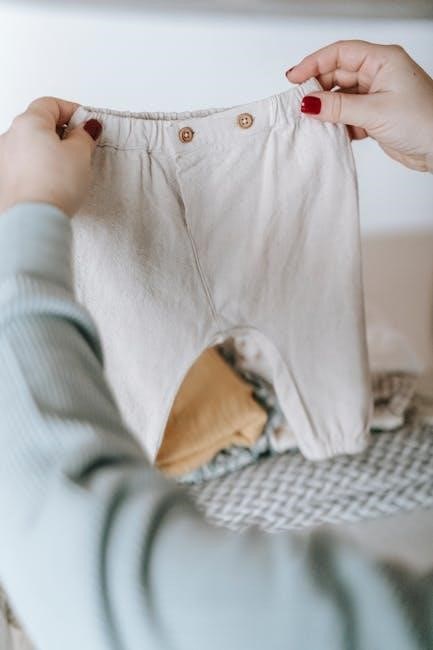A daycare cleaning checklist is an essential tool for maintaining a clean, safe, and healthy environment for children, ensuring adherence to health and safety standards.
1.1 Importance of Maintaining a Clean Daycare Environment
Maintaining a clean daycare environment is crucial for preventing the spread of germs, ensuring children’s safety, and promoting a healthy space for growth and learning. A clean facility reduces the risk of infections and creates a comfortable atmosphere for both children and staff. Regular cleaning also helps comply with health and safety standards, building trust with parents. By prioritizing cleanliness, daycare centers can provide a nurturing environment that supports overall child development and well-being.
1.2 Overview of the Daycare Cleaning Checklist
A daycare cleaning checklist is a comprehensive guide outlining essential tasks to maintain a clean, safe, and healthy environment. It covers daily, weekly, and monthly tasks, ensuring consistency and thoroughness. The checklist includes sanitizing high-touch areas, deep cleaning classrooms, and organizing storage spaces. By following this structured plan, daycare centers can effectively manage cleaning schedules, prevent germ spread, and meet health standards. This tool helps staff stay organized and ensures all areas, from toys to outdoor equipment, are regularly cleaned and disinfected for the children’s well-being.
Daily Cleaning Tasks
Daily tasks include sanitizing toys, wiping surfaces, vacuuming, and mopping floors. Regular disinfection of high-touch areas ensures a germ-free environment, promoting children’s health and safety.
2.1 Morning Cleaning Routine
The morning routine involves preparing the facility for the day. This includes disinfecting high-touch areas like doorknobs and light switches, tidying up classrooms, and restocking supplies. Bathrooms are checked for cleanliness, with soap and toilet paper replenished as needed. Floors are quickly swept or vacuumed to remove debris. Toys and materials are organized to ensure a safe and welcoming environment. Each task is completed efficiently to create a hygienic space for children and staff, setting a positive tone for the day ahead.
2.2 Evening Cleaning Routine
The evening routine focuses on thorough cleaning to prepare for the next day. Surfaces, tables, and chairs are disinfected, while floors are mopped to remove dirt and spills. Trash and recyclables are emptied, and new bags are placed. Toys and materials are sanitized and stored neatly. Bathrooms are cleaned, including sinks, toilets, and mirrors. High-touch areas like door handles and light switches are wiped down. This comprehensive routine ensures the daycare remains clean, hygienic, and ready for the next day’s activities, providing a safe environment for children and staff.
2.3 High-Touch Areas to Disinfect Daily
High-touch areas require daily disinfection to prevent germ spread. These include door handles, light switches, countertops, and toy surfaces. Regularly sanitize playground equipment, bathroom fixtures, and feeding areas. Use approved disinfectants and follow label instructions. Disinfecting these areas reduces the risk of illness, ensuring a safer environment for children and staff. Consistent attention to high-touch zones is crucial for maintaining hygiene and health standards in daycare settings.

Weekly Cleaning Tasks
Weekly cleaning tasks involve deep cleaning classrooms, sanitizing toys, and thoroughly mopping floors to ensure a hygienic environment for children and staff.
3.1 Deep Cleaning of Classrooms
Deep cleaning classrooms involves thorough sanitization of surfaces, dusty areas, and storage spaces. Remove toys and materials, wipe shelves, and disinfect high-touch items. Dust furniture, clean windows, and organize educational materials. Ensure floors are mopped with appropriate cleaning products. Pay attention to corners and areas often overlooked during daily routines. This process helps maintain a germ-free environment and promotes a clean space for learning and play. Regular deep cleaning supports overall hygiene and safety standards in the daycare setting.
3.2 Sanitizing Toys and Educational Materials
Sanitizing toys and educational materials is crucial for removing germs and maintaining a healthy environment. Use a mild detergent or disinfectant suitable for the material type. Soft toys can be machine-washed, while hard surfaces should be wiped down thoroughly. Ensure all items are dry before returning them to circulation. Rotate toys regularly to allow time for sanitization. Additionally, inspect materials for damage or wear and repair or replace as needed. This practice prevents the spread of illnesses and ensures children have safe, clean resources for learning and play.
3.3 Mopping and Vacuuming Floors
Mopping and vacuuming floors are essential for maintaining cleanliness and safety in a daycare. Sweep or vacuum all areas daily to remove dirt and debris. Mop floors with a gentle detergent, focusing on high-traffic zones. Use microfiber mops for effective cleaning and to prevent germ spread. For carpets, vacuum thoroughly, especially in play areas, to reduce dust and allergens. Ensure floors are dry after cleaning to prevent slips. Consider using non-toxic cleaning products to ensure a safe environment for children. Regularly inspect and clean under furniture and rugs to maintain hygiene standards.

Monthly Cleaning Tasks
Monthly cleaning tasks ensure a deeper level of cleanliness and organization in the daycare. These tasks include cleaning outdoor play equipment, organizing storage areas, and sanitizing hard-to-reach spaces like windows and light fixtures to maintain a safe and healthy environment for children. Regular maintenance helps prevent the buildup of dirt and germs, ensuring the daycare remains a clean and welcoming space for everyone. These tasks require careful planning and consistent execution to uphold high standards of hygiene and safety throughout the facility. By scheduling these activities monthly, the daycare can maintain a polished appearance and prevent potential health hazards. This structured approach ensures all areas receive thorough attention, promoting a clean and organized environment that supports the well-being of both children and staff. Additionally, monthly cleaning tasks help in identifying and addressing any maintenance issues early, preventing them from becoming major problems. This proactive approach contributes to the overall longevity of the facility and its equipment, ensuring a safe and nurturing space for learning and growth. Regular deep cleaning also helps in reducing allergens and dust, creating a healthier indoor environment. Overall, incorporating monthly cleaning tasks into the daycare’s routine is essential for maintaining a clean, safe, and organized facility that meets the highest standards of child care. Proper planning and execution of these tasks ensure that every area of the daycare is thoroughly cleaned and maintained, providing a hygienic and comfortable space for daily activities. This consistent effort reflects the daycare’s commitment to the health and well-being of the children and staff, fostering a positive and productive environment. Furthermore, monthly cleaning tasks allow the daycare to stay prepared for inspections and maintain compliance with health and safety regulations. By prioritizing these tasks, the daycare demonstrates its dedication to providing a clean, safe, and supportive setting for children to thrive. In summary, monthly cleaning tasks are vital for upholding the daycare’s standards, ensuring a clean environment, and promoting the health and safety of everyone involved. These tasks are an integral part of the daycare’s maintenance routine and contribute significantly to its overall quality and reputation. By consistently addressing monthly cleaning needs, the daycare can ensure a clean, organized, and healthy space that supports the daily needs of its community. Regular monthly cleaning also helps in identifying areas that may require repair or replacement, allowing the daycare to address these issues promptly. This proactive maintenance prevents potential hazards and ensures that the facility remains safe and functional. Additionally, monthly cleaning tasks can be tailored to address seasonal needs, such as cleaning outdoor equipment in preparation for warmer months or sanitizing windows to allow more natural light. By adapting these tasks to the daycare’s specific needs, the staff can ensure that every area is maintained to the highest standards. Overall, incorporating monthly cleaning tasks into the daycare’s routine is a crucial step in creating and maintaining a clean, safe, and welcoming environment for children and staff alike. This consistent effort not only enhances the daycare’s appearance but also supports the health and well-being of its community, making it an essential part of the facility’s maintenance plan. By prioritizing monthly cleaning tasks, the daycare can ensure a clean, safe, and organized space that meets the needs of everyone involved, fostering a positive and healthy environment for daily activities. In conclusion, monthly cleaning tasks are a fundamental aspect of daycare maintenance, contributing to the facility’s cleanliness, safety, and overall quality. Regular execution of these tasks ensures that the daycare remains a hygienic and comfortable space, supporting the well-being of children and staff. This structured approach to cleaning is essential for upholding high standards and maintaining a positive reputation within the community. By dedicating time and effort to monthly cleaning tasks, the daycare can ensure a clean, safe, and supportive environment that allows children to thrive and grow. This commitment to cleanliness and maintenance reflects the daycare’s dedication to providing a high-quality care setting that meets the needs of its community. In summary, monthly cleaning tasks are a vital component of the daycare’s routine, ensuring a clean, safe, and organized facility that promotes health and well-being. By consistently addressing monthly cleaning needs, the daycare can maintain a polished appearance, prevent potential hazards, and provide a nurturing environment for children to learn and play. This proactive approach to maintenance is essential for upholding the daycare’s standards and ensuring the overall quality of its facilities. By prioritizing monthly cleaning tasks, the daycare can create a clean, safe, and welcoming space that supports the daily activities and well-being of its community. Regular monthly cleaning also helps in identifying and addressing any maintenance issues early, preventing them from becoming major problems. This structured approach ensures that every area of the daycare is thoroughly cleaned and maintained, providing a hygienic and comfortable environment for children and staff. Overall, monthly cleaning tasks are crucial for maintaining a clean, safe, and organized daycare facility that meets the highest standards of child care. By consistently executing these tasks, the daycare can ensure a polished appearance, prevent potential hazards, and provide a supportive setting for children to thrive. This commitment to cleanliness and maintenance reflects the daycare’s dedication to providing a high-quality care environment that supports the health and well-being of its community. In conclusion, monthly cleaning tasks are an essential part of the daycare’s maintenance routine, ensuring a clean, safe, and organized space that promotes daily activities and overall well-being. By prioritizing these tasks, the daycare can maintain a hygienic and comfortable facility, supporting the needs of children and staff alike. This structured approach to cleaning is vital for upholding the daycare’s standards and ensuring a positive environment for growth and development. By consistently addressing monthly cleaning needs, the daycare can ensure a clean, safe, and welcoming space that fosters a positive and healthy community. In summary, monthly cleaning tasks are a fundamental aspect of daycare maintenance, contributing to the facility’s cleanliness, safety, and overall quality. Regular execution of these tasks ensures that the daycare remains a hygienic and comfortable space, supporting the well-being of children and staff. This commitment to cleanliness and maintenance reflects the daycare’s dedication to providing a high-quality care setting that meets the needs of its community. By dedicating time and effort to monthly cleaning tasks, the daycare can ensure a clean, safe, and supportive environment that allows children to thrive and grow. This structured approach to cleaning is essential for upholding high standards and maintaining a positive reputation within the community. Monthly cleaning tasks are a vital component of the daycare’s routine, ensuring a clean, safe, and organized facility that promotes health and well-being. By consistently addressing monthly cleaning needs, the daycare can maintain a polished appearance, prevent potential hazards, and provide a nurturing environment for children to learn and play. This proactive approach to maintenance is essential for upholding the daycare’s standards and ensuring the overall quality of its facilities. By prioritizing monthly cleaning tasks, the daycare can create a clean, safe, and welcoming space that supports the daily activities and well-being of its community. Regular monthly cleaning also helps in identifying and addressing any maintenance issues early, preventing them from becoming major problems. This structured approach ensures that every area of the daycare is thoroughly cleaned and maintained, providing a hygienic and comfortable environment for children and staff. Overall, monthly cleaning tasks are crucial for maintaining a clean, safe, and organized daycare facility that meets the highest standards of child care. By consistently executing these tasks, the daycare can ensure a polished appearance, prevent potential hazards, and provide a supportive setting for children to thrive. This commitment to cleanliness and maintenance reflects the daycare’s dedication to providing a high-quality care environment that supports the health and well-being of its community. In conclusion, monthly cleaning tasks are an essential part of the daycare’s maintenance routine, ensuring a clean, safe, and organized space that promotes daily activities and overall well-being. By prioritizing these tasks, the daycare can maintain a hygienic and comfortable facility, supporting the needs of children and staff alike. This structured approach to cleaning is vital for upholding the daycare’s standards and ensuring a positive environment for growth and development. By consistently addressing monthly cleaning needs, the daycare can ensure a clean, safe, and welcoming space that fosters a positive and healthy community. In summary, monthly cleaning tasks are a
4.1 Cleaning Outdoor Play Equipment
Cleaning outdoor play equipment is essential for maintaining a safe and hygienic environment for children. Start by inspecting the equipment for dirt, debris, or damage. Use mild detergents and water to scrub surfaces, paying attention to high-touch areas like handles and railings. Rinse thoroughly to remove soap residue. For tougher stains or mold, apply a disinfectant suitable for outdoor use. Allow the equipment to dry completely before letting children play. Regular cleaning prevents the spread of germs and ensures the equipment remains durable and safe for daily use. Always follow safety guidelines when using cleaning products outdoors.
4.2 Organizing Storage Areas
Organizing storage areas is crucial for maintaining a clutter-free and efficient daycare environment. Begin by decluttering and removing unnecessary items, ensuring all remaining materials are categorized and neatly stored. Use labeled bins and shelves to promote easy access and visibility. Regularly check expiration dates of supplies and discard outdated materials. Ensure storage areas are well-ventilated and protected from pests. This organization not only enhances safety but also streamlines daily operations, making it easier for staff to locate essential items quickly. A tidy storage space contributes to a more functional and clean daycare facility. Regular maintenance is key to sustaining this order.
4.3 Cleaning Light Fixtures and Windows
Cleaning light fixtures and windows is essential for maintaining a bright and hygienic environment. Dust and dirt on light fixtures can reduce lighting efficiency, while dirty windows obstruct natural light. Use a microfiber cloth and mild detergent to wipe down fixtures monthly. For windows, clean both sides using a glass cleaner and lint-free cloths or squeegees. Remove stubborn dirt or streaks by repeating the process. Ensure all electrical fixtures are turned off before cleaning to prevent accidents. Regular maintenance enhances visibility, improves ambiance, and supports a clean, welcoming space for children and staff. Consistency is key to keeping these areas spotless.
Sanitizing and Disinfecting
Sanitizing and disinfecting are crucial for eliminating germs and maintaining a healthy environment. Use approved products on high-touch areas, following label instructions to ensure effectiveness and safety.
5.1 Best Practices for Sanitizing Surfaces
Sanitizing surfaces is critical to prevent the spread of germs. Always use cleaning products approved for daycare settings and follow the manufacturer’s instructions. Dilute solutions correctly to avoid residue or harm. Focus on high-touch areas like doorknobs, tables, and toys. Allow the solution to sit for the recommended time before wiping clean. Avoid mixing chemicals, as this can create harmful fumes. Regularly sanitize surfaces after meals, naps, and playtime. Train staff to follow a consistent schedule and inspect surfaces to ensure thorough cleaning. This helps maintain a safe environment for children and staff.
5.2 Proper Use of Cleaning Products
Using cleaning products correctly ensures effectiveness and safety. Always read and follow label instructions for dilution and application. Choose products safe for daycare settings, avoiding harsh chemicals. Store cleaning supplies in labeled, locked areas out of children’s reach. Train staff to wear gloves and use well-ventilated spaces to prevent exposure. Regularly inspect products for expiration dates and proper storage. Dispose of unused or expired chemicals safely. Keep a list of used products for emergency reference. Proper use prevents accidents and maintains a healthy environment for children and staff.
5.3 Creating a Disinfection Schedule
A disinfection schedule ensures consistent cleaning and reduces germ spread. Plan daily, weekly, and monthly tasks, focusing on high-touch areas like toys and doorknobs. Assign specific times for disinfecting, using EPA-approved products. Rotate tasks among staff to avoid overload. Include post-illness deep cleans and seasonal adjustments. Track progress with a checklist, ensuring compliance with health guidelines. Regular reviews update the schedule as needed. A clear plan keeps the daycare safe, promoting a healthy environment for children and staff while meeting regulatory standards effectively.

Checklist for Specific Areas
A checklist for specific areas ensures targeted cleaning. Classrooms require daily surface sanitization, storage areas need regular organization, and outdoor spaces demand thorough equipment cleaning. Adapt tasks based on usage.
6.1 Kitchen and Dining Area Cleaning

The kitchen and dining area require thorough cleaning to prevent germ spread. Daily tasks include sanitizing countertops, sinks, and appliances, as well as mopping floors; Ensure all utensils and dishes are cleaned and stored properly. Trash and recyclables should be removed daily and bins disinfected. High-touch areas like faucets and door handles need regular wiping. A deep clean of refrigerators and ovens should occur weekly. Maintain a cleaning schedule to ensure consistency and safety, adhering to health standards for children’s well-being.
6.2 Bathroom and Restroom Maintenance
Bathrooms require regular attention to maintain hygiene. Daily tasks include cleaning and disinfecting toilets, sinks, and mirrors. Ensure soap and paper towel dispensers are filled. Mop floors and restock toilet paper and hand sanitizer. High-touch areas like doorknobs and light switches should be disinfected. Check for and address any odors or spills promptly. Deep clean showers, bathtubs, and trash cans weekly. Keep bathrooms well-ventilated and ensure proper waste disposal. A clean bathroom helps prevent the spread of germs, creating a healthier environment for children and staff.
6.3 Playground and Outdoor Spaces
Playgrounds and outdoor spaces need regular maintenance to ensure safety and cleanliness. Daily, inspect equipment for damage and clean surfaces with mild detergent. Disinfect high-touch areas like swings and slides. Remove debris, leaves, and trash, and sanitize picnic tables or benches. Weekly, deep clean sandboxes and rinse plastic toys. Check for pests and weeds, and secure any loose items. Organize storage areas for toys and tools. Regularly sanitize water play equipment and ensure proper drainage to prevent mold. A clean playground promotes physical health and safety for children during outdoor activities.
Staff Training and Responsibilities
Staff training ensures understanding of cleaning procedures, product use, and health standards. Assigning tasks and fostering accountability guarantees consistent maintenance of cleanliness and safety within the daycare environment.
7.1 Assigning Cleaning Tasks to Staff
Assigning cleaning tasks to staff ensures accountability and efficiency. Each staff member should have clear responsibilities, such as disinfecting high-touch areas or organizing storage spaces.
Rotating tasks periodically helps maintain engagement and ensures all areas receive attention.
By delegating specific duties, the daycare maintains a consistent cleaning schedule and fosters a team-oriented environment.
This approach also allows for quick adjustments based on daily needs or unexpected messes.
Clear communication and task delegation are key to upholding hygiene standards and creating a safe space for children.
7.2 Training on Cleaning Procedures
Proper training on cleaning procedures is crucial for maintaining a hygienic daycare environment. Staff should be educated on best practices, such as using approved cleaning products and following disinfection schedules.
Training should cover techniques for sanitizing high-touch areas, toys, and surfaces effectively.
Emphasize the importance of adhering to health and safety guidelines to prevent the spread of germs.
Regular refreshers and hands-on practice ensure staff confidence and consistency in their cleaning tasks.
This comprehensive approach helps create a clean, safe space for children to thrive.
7.3 Ensuring Compliance with Health Standards
Ensuring compliance with health standards is vital for maintaining a safe and hygienic daycare environment. Regular inspections and audits help verify adherence to cleaning protocols.
Staff should be trained to use approved cleaning products and follow proper disinfection techniques.
Documentation of cleaning tasks ensures accountability and consistency.
Continuous monitoring and feedback allow for timely adjustments to maintain high standards.
By prioritizing health and safety regulations, daycare facilities can protect children, staff, and families from potential health risks.
This commitment fosters trust and confidence in the daycare’s ability to provide a clean and secure space.

Evaluating Cleaning Effectiveness
Evaluating cleaning effectiveness involves regular inspections, feedback collection, and performance assessments to ensure cleaning tasks meet health and safety standards and maintain a clean environment for children.
8.1 Conducting Regular Inspections
Regular inspections are crucial to ensure consistency and quality in cleaning efforts. These inspections should involve checking all areas, including classrooms, bathrooms, and playgrounds. Specific tasks include verifying that surfaces are clean, floors are free of debris, and disinfection schedules are followed. Inspection checklists can help maintain accountability and identify areas needing improvement. By conducting these evaluations regularly, daycare staff can address issues promptly, ensuring a safe and healthy environment for children. Consistency in inspections helps maintain high standards of cleanliness and safety. Regular feedback from inspections can also lead to better cleaning practices and staff training.
8.2 Gathering Feedback from Parents
Gathering feedback from parents is a valuable way to assess the effectiveness of cleaning efforts. Parents can provide insights into areas they feel may need improvement or express concerns about specific cleaning practices. Feedback can be collected through surveys, meetings, or suggestion boxes. This involvement fosters a sense of collaboration and ensures that parents feel heard. Their input can help identify overlooked areas or suggest new cleaning strategies. By incorporating parent feedback, daycare centers can enhance their cleaning protocols and build trust within the community. Regular communication ensures a cleaner, safer environment for all children. Parental involvement strengthens overall quality.
8.3 Adjusting the Cleaning Schedule as Needed
Regularly reviewing and adjusting the cleaning schedule is crucial to ensure it remains effective. Factors like high-traffic areas, seasonal changes, or special events may require more frequent cleaning. Feedback from staff and parents can help identify areas needing additional attention. Adjustments should prioritize tasks that directly impact health and safety, such as disinfecting high-touch surfaces or deep cleaning classrooms. A flexible schedule allows the daycare to adapt to changing needs, ensuring a consistently clean environment. By staying proactive, the daycare can prevent the spread of germs and maintain a safe space for children. Regular updates keep the cleaning routine aligned with daily operations.
Involving Parents in Cleaning Efforts
Involving parents in cleaning efforts fosters a collaborative environment and shared responsibility. Sharing the cleaning checklist and encouraging contributions promotes a sense of ownership and a cleaner, safer daycare.
9.1 Communicating the Importance of Cleanliness
Effective communication about cleanliness is vital for involving parents. Emphasize how a clean environment reduces germs and illnesses, ensuring children’s health and safety. Share the daycare cleaning checklist to show the efforts made. Explain the role parents can play in maintaining hygiene, such as reinforcing handwashing habits. Regular updates and transparency about cleaning procedures help build trust. By highlighting the benefits, parents are more likely to support and participate in keeping the daycare clean and germ-free.
9.2 Encouraging Parent Volunteers for Cleaning
Encouraging parent volunteers for cleaning fosters a collaborative environment and strengthens community involvement. Share the daycare cleaning checklist to highlight areas needing attention. Create a volunteer schedule or sign-up sheet for tasks like sanitizing toys or organizing storage areas. Recognize and appreciate their contributions to motivate continued participation. Clear communication about cleaning procedures ensures everyone understands expectations. By involving parents, you not only lighten the workload but also build trust and a sense of responsibility for maintaining a clean, safe space for children.
9.3 Providing Guidance for Parent-Staff Cleaning Events
Organize parent-staff cleaning events by providing clear guidance and structured tasks. Share the daycare cleaning checklist to outline specific areas and activities, ensuring everyone understands their roles. Assign tasks based on individual skills and preferences to maximize efficiency. Provide training on best practices for sanitizing and disinfecting to ensure safety and effectiveness. Supervise activities to maintain quality standards and ensure child safety during the process. Encourage teamwork and camaraderie to make the experience enjoyable. Recognize contributions and express gratitude to foster a sense of community and shared responsibility for maintaining a clean environment;
Consistency is key in maintaining a clean daycare. Adhere to the checklist to ensure a healthy, safe environment, promoting child well-being and development.
10.1 Summary of Key Cleaning Practices
Implementing a structured daycare cleaning checklist ensures a hygienic environment. Daily tasks include disinfecting high-touch areas, while weekly deep cleans and monthly sanitization maintain long-term safety. Training staff and involving parents in cleaning efforts fosters a collaborative approach to health standards. Regular inspections and feedback loops allow for continuous improvement, ensuring the daycare remains a safe space for children to thrive. Consistency and adherence to these practices are vital for promoting well-being and preventing the spread of germs.
10.2 Final Tips for Maintaining a Clean Daycare
Consistency is key to maintaining a clean daycare. Assign tasks clearly, use eco-friendly products, and schedule regular deep cleans. Involve parents through volunteer days to foster a sense of community. Ensure all areas are well-ventilated and clutter-free to prevent germ buildup. Regularly review and update your cleaning checklist to adapt to changing needs. By prioritizing cleanliness, you create a safe, healthy environment where children can thrive and learn. Remember, a clean daycare is not just a facility—it’s a foundation for the well-being of the children in your care.
